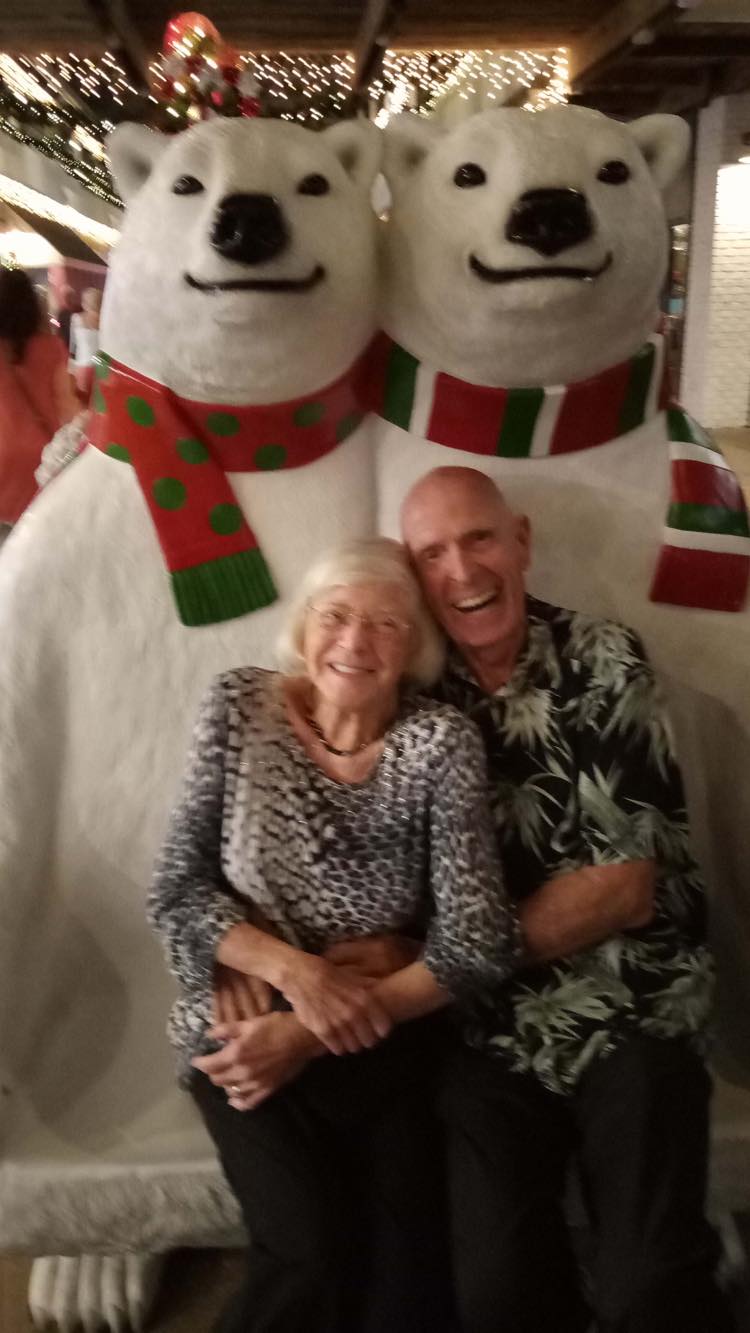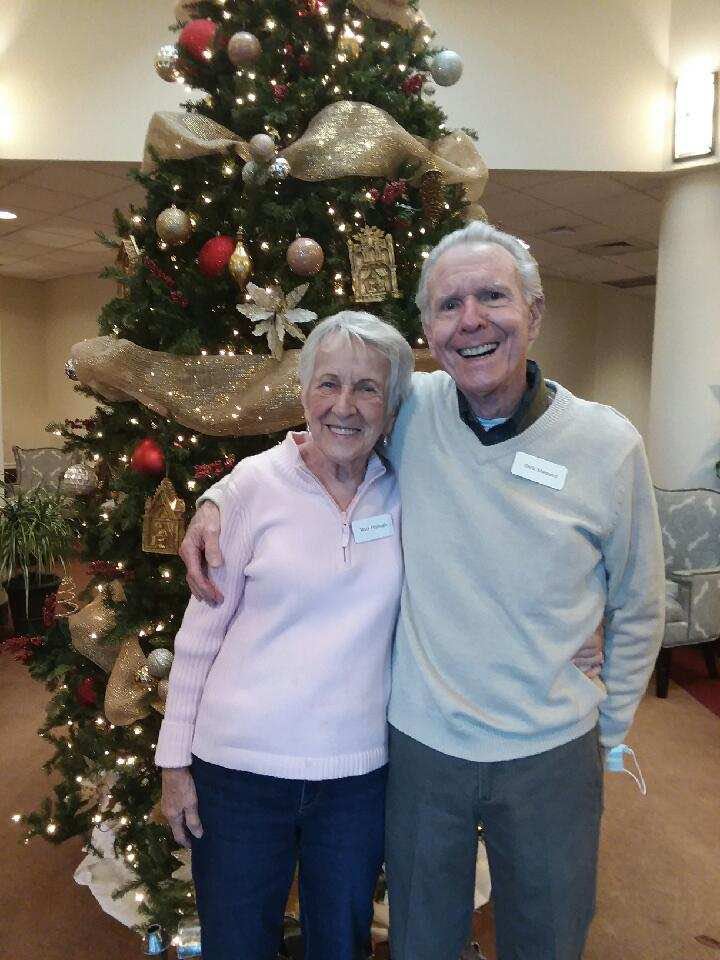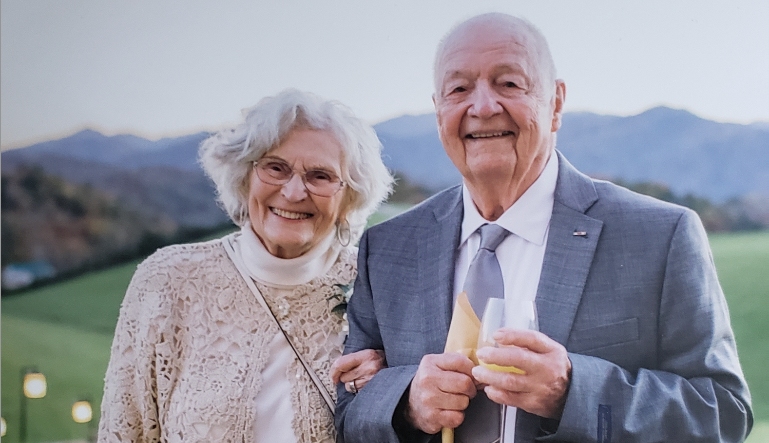Never too Late to Date: Senior Couples Share Their Top Dating Advice and Tips for Older Adults
Five Star- FL
For more information about the author, click to view their website: Five Star Senior Living
Aug 26, 2023
Florida - Southwest
Email US
Click to Email UsSome things never change as we get older. Take dating, for instance. Whether it was asking your crush to the homecoming dance in high school or inviting a new neighbor to dinner as an older adult, igniting that romantic spark is intimidating, no matter your age. It can also feel later in life like dating is a young person’s game and you’re past the point of starting a new relationship.
The truth is romance doesn’t have an age limit. Just ask these four couples who met as seniors—Henry and Joyce, Mary and Dick, Mary and Tom, and Jodi and Myrna—who found joy, love and a new beginning with their partners. There’s no better time than the present to tell that special someone in your life how much they mean to you, and maybe start a new romantic adventure of your own. That’s why we asked our featured senior couples for their best senior dating advice. Here you’ll find their four top senior dating tips to remember that can help you take that first step and build a loving bond that endures.
Senior Dating Tip #1: Join in activities
Few things are as key to forming a romantic connection as being in the right place, at the right time. Take it from Henry, 86, and Joyce, 85, residents of The Forum at the Woodlands, who met on the bus on the way to go walking at the mall. The pair struck up a conversation that quickly evolved into sitting together at Woodlands concerts, dancing together every Friday and eventually moving in together. The most important thing, they said, was putting themselves out there and participating in the many activities available to them.
“It’s much easier than dating as a young person because we had activities that brought us together; we didn’t have to create something,” says Joyce. “The best thing to do is to get involved, go to the socials and be open to meeting other people.”
Senior Dating Tip #2: Open your heart to something new
 A sad truth of dating as an older adult is that many single seniors may be widows who have lost a wife/husband dear to them. When Mary Lee, 90, met Tom, 90, after he moved into Calusa Harbour, she was interested in him romantically but could see that he was still mourning his wife whom he’d recently lost. She knew the feeling all too well after losing three husbands of her own. Yet, once the two shared a hamburger, started attending church together and shared a first kiss—“I was walking on clouds and bumping into everything after,” says Tom—they realized that they could care for each other in their grief while also starting a beautiful new life together.
A sad truth of dating as an older adult is that many single seniors may be widows who have lost a wife/husband dear to them. When Mary Lee, 90, met Tom, 90, after he moved into Calusa Harbour, she was interested in him romantically but could see that he was still mourning his wife whom he’d recently lost. She knew the feeling all too well after losing three husbands of her own. Yet, once the two shared a hamburger, started attending church together and shared a first kiss—“I was walking on clouds and bumping into everything after,” says Tom—they realized that they could care for each other in their grief while also starting a beautiful new life together.
“Most everyone has lost someone,” says Mary Lee. “You can’t try to replace somebody; you just look for someone you fall in love with. You’ll find somebody but not necessarily like someone you had.”
Senior Dating Tip #3: Maintain independence
 Both Mary, 85, and Dick, 80, weren’t exactly looking for a mate when they moved into The Forum at Brookside. Mary just wanted a companion to join her on morning walks. Their first walk together was on Dick’s birthday after he became a Brookside resident, and “we’ve been together ever since,” says Mary. Now, the pair are practically inseparable and when not together people often ask where the other is. Yet there’s one thing they don’t budge on: separate apartments. That’s because, both agree, one of the secrets to healthy senior relationship is letting the other have their own space and independence.
Both Mary, 85, and Dick, 80, weren’t exactly looking for a mate when they moved into The Forum at Brookside. Mary just wanted a companion to join her on morning walks. Their first walk together was on Dick’s birthday after he became a Brookside resident, and “we’ve been together ever since,” says Mary. Now, the pair are practically inseparable and when not together people often ask where the other is. Yet there’s one thing they don’t budge on: separate apartments. That’s because, both agree, one of the secrets to healthy senior relationship is letting the other have their own space and independence.
“It’s nice that we have our own villa so we can spend some time away to take care of personal tasks,” says Dick. “I’m the king of my castle and she’s the queen of her castle!”
Senior Dating Tip #4: Take a risk and enjoy every moment
 Jodi and Myrna, both 77-year-old residents of The Forum at Town Center, have shared experiences in their 25 years together many of us simply dream of. They’ve been hiking in New Zealand, taken a Niagara Falls boat tour and even lived in an RV traveling across the U.S. for 14 years. That’s because ever since Jodi, a former minister, took a chance to ask Myrna, a new congregant at her church, out to dinner, the pair have shared the same philosophy of making every moment together an adventure. Both also have an understanding that at their age, you don’t grow together to start a family, leaving more time to concentrate on each other. The first step into the unknown of senior dating is the hardest part, they say, but the “wonderful road ahead” awaits for those who take the risk.
Jodi and Myrna, both 77-year-old residents of The Forum at Town Center, have shared experiences in their 25 years together many of us simply dream of. They’ve been hiking in New Zealand, taken a Niagara Falls boat tour and even lived in an RV traveling across the U.S. for 14 years. That’s because ever since Jodi, a former minister, took a chance to ask Myrna, a new congregant at her church, out to dinner, the pair have shared the same philosophy of making every moment together an adventure. Both also have an understanding that at their age, you don’t grow together to start a family, leaving more time to concentrate on each other. The first step into the unknown of senior dating is the hardest part, they say, but the “wonderful road ahead” awaits for those who take the risk.
“As seniors, we don’t know how much time we have left,” says Jodi. “Don’t waste it being unhappy not having someone in your life. We all need human companionship. If there is someone in your life you think would make a great companion, go for it!”
Finding community and companionship at Five Star
There’s certainly no shortage of stories of new couples and friends that met in a Five Star Senior Living community. Every day at one of our communities across the U.S. brings more opportunities for connection from fun and diverse activities to a stress-free, independent lifestyle that allows more time for the things—and people—that matter most. Take it from Henry and Joyce: “Life isn’t over after 90, you can live and love.” Contact one of our senior living experts or find a Five Star community near you to learn more and start your next chapter of life—and possibly love—with us.
- To view the original version of this article visit www.fivestarseniorliving.com/blog/senior-dating-advice-and-tips
- Seniors Blue Book was not involved in the creation of this content.
Other Articles You May Like
The Importance of Staying Hydrated Comfort Keepers of Grand Junction
Warmer weather is a great invitation to enjoy the outdoors and nature. Staying hydrated is essential for maintaining health and keeping critical bodily functions working properly. Hydration can be a challenge for some seniors because seniors may have a diminished ability to sense thirst, notice changes in body temperature, and may be taking medications that have a dehydrating effect. Keeping a few tips in mind will ensure that seniors stay hydrated and continue to enjoy the activities that bring them joy.Older adults looking to stay hydrated throughout the day should try these tips to get started. Being dehydrated can cause confusion, headaches, elevated heart rate, muscle weakness, and fatigue. Seniors who think they may be dehydrated should discuss their symptoms with their doctor before changing their fluid intake. Seniors should discuss hydration with their doctor as only can a healthcare professional recommend how much water someone needs, and they can also provide guidance and tips on managing water intake. Create a schedule drinking a lot of water in one sitting can be difficult. However, creating a schedule that accounts for daily activity, physician-recommended intake levels, and the preferences of the senior can help keep hydration on track. Eat water-rich foods cucumbers, watermelon, apples, and other water-rich produce can help seniors get more fluids at mealtimes. Broth is also a good option. Make water more interesting For those that dont enjoy drinking water, adding small amounts of juice or flavoring to water can make it less boring. Popsicles are also a great optionespecially on warm days! Reduce water loss excessive sweating can contribute to dehydration keeping inside temperatures at a reasonable level, and being mindful of fluid loss during outside activities, can help seniors stay hydrated. Dont wait for thirst often, when seniors feel thirsty; they may already be dehydrated. Comfort Keepers Can HelpComfort Keepers can provide support for seniors that are concerned about the issue of hydration. Our caregivers can provide transportation to healthcare appointments, assist with meal preparation and planning, and provide support for physician-prescribed hydration regimens. Our goal is to support physical and emotional care goals and to elevate the spirits of our clients and their families every day.To learn more about our in-home care services, contact your local Comfort Keepers location today by calling (970) 241-8818 References Centers for Disease Control and Prevention. Get the Facts: Drinking Water and Intake. Web. 2016. FamilyDoctor.org. Hydration: Why Its So Important. Web. 2017. Mayo Clinic. Dehydration. Web. 2018. WebMD. What is Dehydration? What Causes It? Web. 2019 Healthline The Causes and Symptoms of Dehydration in Older Adults
Guest Blog: Getting Outside Gets Inside
It is a sad commentary on our current cultural worldview that sunlight is widely perceived to be harmful, a cancer-causing threat. But what does the research actually say? And does this research affect older adults differently than other people?Spectrum: For starters, we should understand that sunlight is a complex combination of photons, with different wavelengths and properties. The sun is the original full-spectrum illumination, while both incandescent and LED lights emit, as one might expect, mostly visible-spectrum light.Intensity: The other important variable is the intensity of light, measured in LUX units (a foot away from one candle): direct sun comes in at 100,000; a cloudy day at 1,000; a kitchen or office measures 500; and a living room only 50. Thats why you need to get outside.UV: At one extreme is ultraviolet light (UV), whose wavelength is slightly shorter than visible violet. With regard to our health, UV is a mixed bag.It does cause sunburns, damages DNA, and triggers the aging of skin. It is also statistically associated with malignant melanoma, although, curiously, not with increased deaths from melanoma (because these cancers are mostly treatable).On the other hand, there are numerous health benefits: UV lowers the risk of hypertension, diabetes, atherosclerosis (hardening of the arteries), blood inflammation, and COVID infections. UV also stimulates Vitamin D synthesis in the skin. A large-scale study of 500,000 Brits, with a 12-year follow-up, found that frequent UV exposure lowered all-cause mortality by 14%, with cardiovascular deaths down 21% and total cancer mortality decreased by 13%. It gives one pause to reconsider the vast sums spent on sunscreen lotions. Just wearing light summer clothing blocks 80% of UV.IR: UV radiation represents only about 3% of the sunlight that strikes the surface of the earth, while about 50% is infrared (IR), whose lightwaves are just beyond (longer) than visible reds. IR radiation is more predominant at the beginning and end of days, while UV is strongest when the sun is overhead. A thick cloud cover reduces IR significantly more than UV. In a recent superb Huberman Lab podcast, Dr. Roger Seheult touted the many benefits of IR radiation. Most severe and chronic diseases also involve mitochondrial dysfunction (mitochondria are the small organelles within a cell that produce the energy-generating chemical ATP). One aspect of aging is that we lose 70% of our mitochondrial functioning after age 40. Unlike UV, IR radiation passes through light clothing and the surface of the skin to penetrate deep into body tissues, where it significantly stimulates mitochondrial ATP synthesis.Effects: The effects of improved mitochondrial functioning are pervasive, correlated empirically with sun exposure. Dr. Seheult cited statistics demonstrating that the greatest number of all-cause mortality comes soon after the shortest day of the year, and the lowest number of deaths occurs close to the longest days.People who live far north or south of the equator where days are particularly short in winter have higher overall mortality rates, particularly in mid-winter. In a study of almost 30,000 Swedish women, avoidance of sun exposure carried the same risk of premature death, as did smoking.There is well-replicated rigorous research that moderate IR exposure lowers the risk of cancer, heart disease, diabetes, hypertension, and it reduces blood lipids and chronic inflammation. IR increases immune system response to infections, such as influenza, COVID and pre-cancerous cells.On a sunny day, just 15 minutes outside can make a big difference. If youre in a green space with lots of grasses, leaves, bushes, and trees, you can receive two to three times the IR dose because plants reflect much of the IR that strikes them (notice that most leaves dont get hot in the sun because of these reflective properties).Red Light Therapy: There are many red-light therapy devices now available if you are considering them, be sure to carefully research IR wavelengths, dosage, safety, and therapeutic benefit. One study, utilizing an IR desk unit shining only on face, neck, and hands, proved to be quite therapeutic.Forest Bathing? Dr. Seheult delighted in reminding us of the wisdom of the ancient beliefs that sunlight and fresh air promote convalescence. Forest bathing has become a thing the air around trees is infused with phytoncides that defend plants from bacteria, fungi, and insects. When inhaled by humans, they up- regulate immune functioning and lower stress levels, and reduce stress hormones. The beauty and serenity of such an environment further enhances these benefits, some of which are detectable by lab tests a month later. Furthermore, getting up with the sun (and out from behind the filtering effects of plate glass windows) helps to set your circadian rhythm, which can improve sleep patterns. Take home message: forests, parks and even golf courses soothe the soul, and the body. And early morning and late afternoon may be particularly beneficial.Sweat Benefits: Dr. Seheult is a pulmonologist who treats many respiratory infections he also reminded us about how previous generations treated patients with hot baths and hot packs, as if to sweat out infections. Its been recently discovered that body temperatures a little over 100 degrees Fahrenheit actually accelerate the production of interferon, a powerful anti-viral protein. Maybe weve been a little too quick to reduce our fevers with aspirin, Tylenol, and Advil. And maybe the saunas so favored by Scandinavians and Russians are more therapeutic than weve realized.Conclusion: As spring has sprung, we encourage everyone to get away from your screens, go outside and enjoy the benefits of the sunshine that so amply surrounds us. Residents at Kavod Senior Life have a myriad of ways to get outside, whether it be on the sunlit patio areas, in the resident gardens, on the nearby walking paths in Cherry Creek or on the many benches and sitting areas surrounding the campus. Come for a visit and see for yourself!Ben and Scott https://theagingwiselyproject.com/
Providing Specialized Care for Vietnam Veterans While Understanding Their Lifelong Battle
By Faith Protsman, MD, Regional Medical Director, VITAS HealthcareVietnam War veterans face unique obstacles throughout the twilight of advanced illness. For hospice care providers to tailor care to meet the needs of veterans who have served in this theater of war, they must consider the tribulations these patients face as they reach the end of their lives.The Vietnam War era was a very tumultuous time to be a soldier. The United States' prolonged involvement in a war of questionable motivation left society with disdain toward the government and its institutions, especially the military.Coupled with horrific images shown on television, constant controversy was a new reality and negative public opinion formed around this conflict, of which those serving the nation were not spared.Careful consideration is necessary when treating patients facing these traumas.Tours of duty proved to be traumatizing in many ways. Young soldiers, some having just turned 18, were drafted into a war that many of them did not believe in. They were not fighting for love of country and God; rather, they were fighting for survival and out of fear for their lives.Intimate battles in the dense jungle led many to be subjected to the horrors that come with fighting in a foreign land that was only familiar to the elusive guerilla enemy soldiers.Servicemembers did not receive a warm welcome when returning home from Vietnam, often being judged and labeled as cruel and even inhumane.Moral Injury Can Impair Mental HealthThis perfect storm of trauma led to lasting moral injury that plagues many veterans for their entire lives. Veterans returning from the war were marginalized and pushed into isolation, often turning to alcohol and substance abuse, which worsened their anxiety and exacerbated their strife.Questions like Ive never spoken about the war, can I now? Was the war moral or immoral? and Was I a good soldier? come bubbling to the surface later in life as their illnesses intensify and their defenses weaken.Careful consideration is necessary when treating patients facing these traumas.The restlessness that can result from post-traumatic stress disorder (PTSD) is often treated with benzodiazepines. In most cases, these medications can bring relief through calming the patient.Yet, there is a common trend amongst veterans who cope with trauma that results in the opposite effect.Benzodiazepines can lower the walls that Vietnam veterans have built up throughout a lifetime of suppressing trauma and negative memories. This class of medications can exacerbate the symptoms of PTSD as traumatic experiences and feelings of regret resurface. Benzodiazepine-induced inhibition of neurotransmission can even lead to agitated toxic psychosis, increased anxiety, hostility, and rage.1The Value of Compassion Along with Clinical CareRemaining considerate does not end with simply staying mindful during the planning of clinical solutions. Providing care for Vietnam veterans requires a high level of empathy.A key to an empathetic approach is taking the time to listen nonjudgmentally. Though seemingly simple, practicing nonjudgmental, open communication with patients facing trauma from war can help avoid the all-too typical responses of Its okay and You did what you had to do.These patients do not need sympathy, because they have been judged enough throughout their lives. When care teams approach them without judgment, they honor the sacrifices these heroes have made.VITAS hospice care provides compassionate care approaches that are tailored to meet the distinctive needs of Vietnam veterans. With the Veterans Administration (VA) offering hospice care as part of its medical package, VITAS team members can provide empathetic psychosocial support, while utilizing clinical solutions that help manage symptoms.The qualifications for veterans to receive hospice benefits include: A life-limiting illness Treatment goals that focus on comfort, rather than curative treatments A life expectancy of 6 months or less, if their illness runs its normal course Veterans also benefit from the option to receive concurrent care through the VA. The VA can provide curative treatments as the patient simultaneously receives symptom-managing comfort care administered by the hospice care provider of their choosing.Offering solace, while remaining compassionate when patients need it most, is too often overlooked in the busy practice of healthcare. Acknowledging the adversity that Vietnam War veterans have had to face throughout their lifetimes and adapting care approaches to meet their needs is the best way for healthcare providers to give back to those who have sacrificed so much for the preservation of freedom.1Paton, C. (2018, January 2). Benzodiazepines and disinhibition: A review: Psychiatric bulletin. Cambridge Core. Retrieved November 2, 2022, from https://www.cambridge.org/core/journals/psychiatric-bulletin/article/benzodiazepines-and-disinhibition-a-review/421AF197362B55EDF004700452BF3BC6
